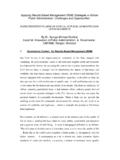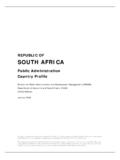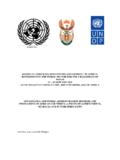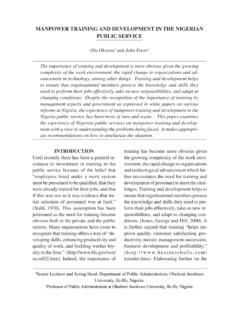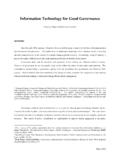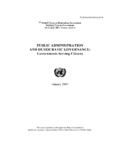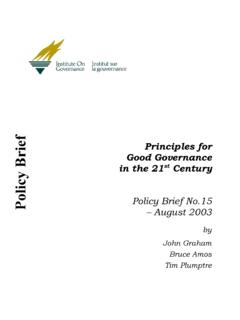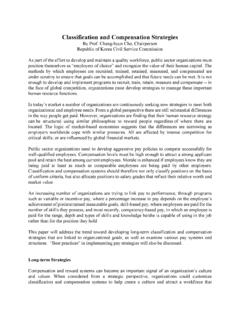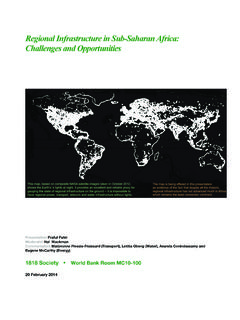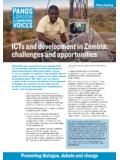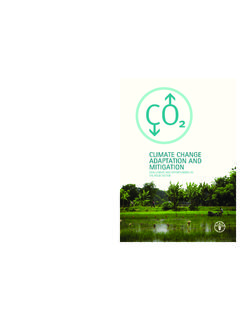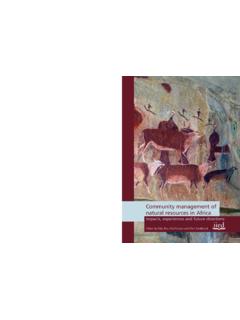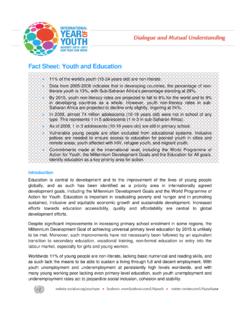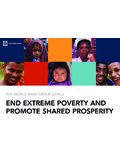Transcription of Public administration and development - United Nations
1 United Nations A/60/114. General Assembly Distr.: General 12 July 2005. Original: English Sixtieth session Item 43 of the preliminary list *. Report of the Economic and Social Council Public administration and development Report of the Secretary-General Summary In response to the request of the General Assembly in its resolution 59/55 of 2 December 2004, and as a follow-up to the reports previously submitted by the Secretary-General in 2002, 2003 and 2004 (A/57/262-E/2002/82, A/58/152 and A/59/346), the present report highlights the development challenges facing Member States, and, on the basis of the responses to a questionnaire submitted to the Member States, it reviews the measures adopted in the last 5 to 10 years to respond to those challenges through the revitalization of Public administration systems.
2 The report further considers the lessons learned by Member States in making the transition from externally influenced to home-grown and demand-driven Public administration reforms. The future of Public administration , according to the report, lies in the institution of measures aimed not only at reaffirming the developmental role of Public administration and upholding its core values, but also at reconfiguring Public service organizations into open, participative, knowledge-sharing, innovating and results-oriented service-delivery systems. Among the tensions that are expected to arise in the study and practice of Public administration in coming years are those between the demand for change and the need for institutional tradition (and memory); between managerial flexibility and the integrity of rules; between domestic concerns and supranational obligations; and between pressing, short-term problems and long-term, strategic issues.
3 Above all, the report stresses the need to strengthen the role of the United Nations in Public administration , particularly with respect to collaborating with Member States and other partners in the implementation of capacity-building and knowledge-sharing initiatives in support of Public administration reform. * A/60/50 and 05-41843 (E) 050805. *0541843*. A/60/114. Contents Paragraphs Page I. Introduction .. 1 5 3. II. Global challenges and Public administration .. 6 17 4. III. Public administration revitalization: dominant concerns, thrusts for reform and emerging trends .. 18 32 6. IV. Lessons learned by Member States from the reform process .. 33 44 11. A. Appreciating the complexity and holistic nature of modern Public administration .. 34 35 12. B. Finding the winning revitalization strategies.
4 36 12. C. Focusing on quick wins .. 37 38 13. D. Acquiring and building capacities for reform and revitalization .. 39 41 13. E. Financing the revitalization of Public administration .. 42 14. F. Handling the politics of change .. 43 14. G. Acknowledging the role of leadership in the revitalization process .. 44 14. V. Future directions in the revitalization of Public administration .. 45-55 15. A. Status and identity of Public administration .. 46 47 15. B. Information-sharing among Member States .. 48-51 15. C. Capacity-building and human resource development .. 52 55 16. VI. Conclusions and recommendations .. 56 59 17. Annex Questionnaire for the Governments of the Member States .. 20. 2 05-41843. A/60/114. I. Introduction 1. In its resolution 59/55 of 2 December 2004, the General Assembly requested the Secretary-General to submit a report to its sixtieth session on progress made in Member States by revitalizing Public administration during the last 10 years.
5 The present report sets out to meet that request. 2. The report builds on an earlier one entitled Five-year assessment of the progress made in the implementation of General Assembly resolution 50/225 on Public administration and development (A/56/127-E/2001/101). The 2001. assessment identified a number of priorities in Public administration reform, among them promoting democratization and decentralization; developing legal and institutional frameworks and economic governance systems; implementing ethics and anti-corruption strategies; improving resource mobilization and financial management systems; and tapping the potential of e-government. The 2001 report noted a close affinity between the reforms being instituted in many countries and the priorities identified in resolution 50/225.
6 Above all, it concluded that the sustainability of ongoing reform programmes hinged on substantial investment in human and institutional capacity-building. 3. To update and deepen the understanding of Public administration reforms implemented in the last 10 years, the Secretariat requested the Member States to respond to a questionnaire (annex I) targeting a variety of Public administration revitalization measures undertaken to promote macroeconomic stability and economic growth, human development and achievement of the Millennium development Goals, civil society participation in the policy and development process, responsiveness to citizen concerns, conflict prevention and resolution efforts, Public safety and security, transparency and accountability, efficiency, effectiveness and any other priorities unique to each of the respondent countries.
7 The United Nations regional commissions and regional Public administration organizations were approached with the same set of questions. 4. Responses were received from 40 countries spread over five continents and from the Economic and Social Commission for Western Asia. The countries were Albania, Algeria, Argentina, Austria, Barbados, Belarus, Bolivia, Bulgaria, Cape Verde, Cyprus, the Dominican Republic, Egypt, El Salvador, Fiji, Finland, Georgia, Guatemala, Hungary, Kazakhstan, Kuwait, Latvia, Madagascar, Morocco, Nepal, New Zealand, Norway, Panama, the Philippines, Poland, Portugal, Qatar, the Russian Federation, Serbia and Montenegro, Singapore, Slovakia, Slovenia, Spain, Trinidad and Tobago, the United Republic of Tanzania and Venezuela (Bolivarian Republic of). 5. Using the responses from Member States and additional materials (particularly those collected from global and regional conferences on Public administration ) as a point of departure, the present report offers global, rather than country-specific, perspectives in Public administration revitalization.
8 Based on the premise that revitalization is a dynamic process, the report provides snapshots of reform and revitalization efforts within and across the world regions. Against the backdrop of the momentous socio-economic changes taking place worldwide, the report highlights the challenges confronting Public administration systems as they implement different types of innovative and capacity-strengthening measures. Among the issues raised in the report are those concerning the scope, impact and 05-41843 3. A/60/114. sustainability of Public administration reforms; the capacities needed to design, implement and monitor the reforms; and the strategies to be employed in surmounting obstacles to change. II. Global challenges and Public administration 6. The challenges facing Public administration worldwide have multiplied since the adoption by the General Assembly of resolutions 49/136 of 19 December 1994.
9 And 50/225 of 19 April 1996. The world has, in the last few years, witnessed dramatic changes, among them the accelerated development of information and communication technologies, the emergence of trading blocs and economic unions, mass migrations accompanied by the tightening of border controls, growing intercultural interactions (marked at times by mutual understanding and at others by tension), economic liberalization (with an increasing risk of exposing national economies to global crises), expanding opportunities for the movement of goods and capital, climatic and environmental changes with catastrophic consequences,1 the marketing of new drugs and genetically modified food products and the discovery of mysterious diseases2 that recognize no political or geographical boundaries. 7.
10 While many countries were still struggling with the new realities of globalization and liberalization and were in the process of introducing a variety of governance and economic reforms, the events of 11 September 2001 occurred, placing security firmly on the Public policy agenda in a number of them. Nonetheless, around the world there is an increasing realization that security needs to be broadly defined to include human concerns, particularly concerns for the socio-economic welfare of the people, for freedom from want and for civic and individual rights, including the right to development along separate but mutually non-threatening paths. 8. How quickly developing countries, particularly the least developed ones, emerge from poverty and achieve improved living standards depends partly on the support of the international community but also on the effectiveness of national Public administration systems in implementing the poverty reduction components of the Millennium development Goals.
